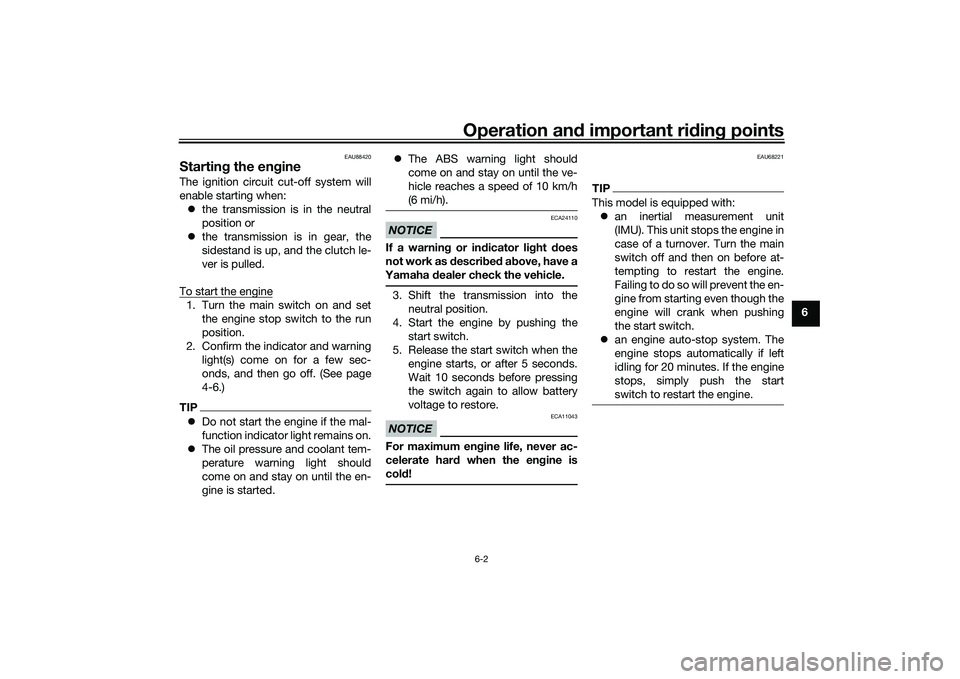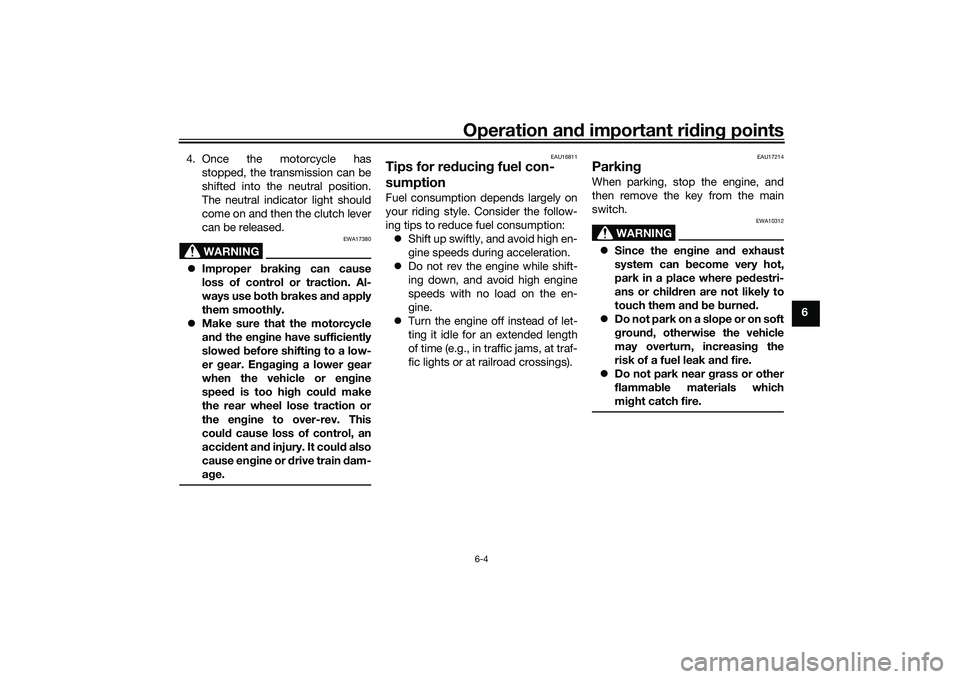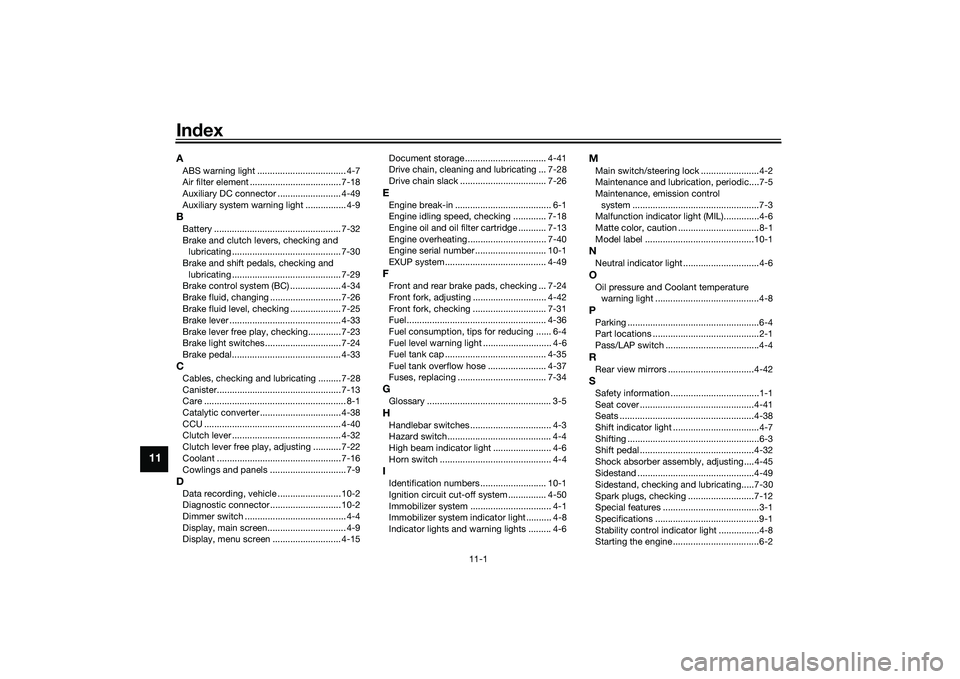warning light YAMAHA YZF-R1 2022 User Guide
[x] Cancel search | Manufacturer: YAMAHA, Model Year: 2022, Model line: YZF-R1, Model: YAMAHA YZF-R1 2022Pages: 136, PDF Size: 6.01 MB
Page 79 of 136

Operation and important riding points
6-2
6
EAU88420
Starting the engineThe ignition circuit cut-off system will
enable starting when: the transmission is in the neutral
position or
the transmission is in gear, the
sidestand is up, and the clutch le-
ver is pulled.
To start the engine1. Turn the main switch on and set the engine stop switch to the run
position.
2. Confirm the indicator and warning light(s) come on for a few sec-
onds, and then go off. (See page
4-6.)TIPDo not start the engine if the mal-
function indicator light remains on.
The oil pressure and coolant tem-
perature warning light should
come on and stay on until the en-
gine is started.
The ABS warning light should
come on and stay on until the ve-
hicle reaches a speed of 10 km/h
(6 mi/h).
NOTICE
ECA24110
If a warning or indicator light does
not work as described above, have a
Yamaha dealer check the vehicle.3. Shift the transmission into the
neutral position.
4. Start the engine by pushing the start switch.
5. Release the start switch when the engine starts, or after 5 seconds.
Wait 10 seconds before pressing
the switch again to allow battery
voltage to restore.NOTICE
ECA11043
For maximum engine life, never ac-
celerate hard when the engine is
cold!
EAU68221
TIPThis model is equipped with: an inertial measurement unit
(IMU). This unit stops the engine in
case of a turnover. Turn the main
switch off and then on before at-
tempting to restart the engine.
Failing to do so will prevent the en-
gine from starting even though the
engine will crank when pushing
the start switch.
an engine auto-stop system. The
engine stops automatically if left
idling for 20 minutes. If the engine
stops, simply push the start
switch to restart the engine.
UB3LE1E0.book Page 2 Tuesday, August 10, 2021 2:28 PM
Page 81 of 136

Operation and important riding points
6-4
6
4. Once the motorcycle has
stopped, the transmission can be
shifted into the neutral position.
The neutral indicator light should
come on and then the clutch lever
can be released.
WARNING
EWA17380
Improper braking can cause
loss of control or traction. Al-
ways use both brakes and apply
them smoothly.
Make sure that the motorcycle
and the engine have sufficiently
slowed before shifting to a low-
er gear. Engaging a lower gear
when the vehicle or engine
speed is too high could make
the rear wheel lose traction or
the engine to over-rev. This
could cause loss of control, an
accident and injury. It could also
cause engine or drive train dam-
age.
EAU16811
Tips for reducing fuel con-
sumptionFuel consumption depends largely on
your riding style. Consider the follow-
ing tips to reduce fuel consumption:
Shift up swiftly, and avoid high en-
gine speeds during acceleration.
Do not rev the engine while shift-
ing down, and avoid high engine
speeds with no load on the en-
gine.
Turn the engine off instead of let-
ting it idle for an extended length
of time (e.g., in traffic jams, at traf-
fic lights or at railroad crossings).
EAU17214
ParkingWhen parking, stop the engine, and
then remove the key from the main
switch.
WARNING
EWA10312
Since the engine and exhaust
system can become very hot,
park in a place where pedestri-
ans or children are not likely to
touch them and be burned.
Do not park on a slope or on soft
ground, otherwise the vehicle
may overturn, increasing the
risk of a fuel leak and fire.
Do not park near grass or other
flammable materials which
might catch fire.
UB3LE1E0.book Page 4 Tuesday, August 10, 2021 2:28 PM
Page 96 of 136

Periodic maintenance and adjustment
7-15
78. Start the engine, and then let it idle
for several minutes while checking
it for oil leakage. If oil is leaking,
immediately turn the engine off
and check for the cause.
TIPAfter the engine is started, the oil pres-
sure and coolant temperature warning
light should go off if the oil level is suf-
ficient.NOTICE
ECA22490
If the oil pressure and coolant tem-
perature warning light flickers or re-
mains on even if the oil level is
correct, immediately turn the engine
off and have a Yamaha dealer check
the vehicle.9. Turn the engine off, wait a few mi-nutes for the oil level to settle for
an accurate reading, and then
check the oil level and correct it if
necessary. To change the engine oil and replace
the oil filter cartridge
1. Remove cowling A and panel C. (See page 7-9.)
2. Follow steps 1–3 of the “To chan- ge the engine oil” section for the
oil draining procedure.
3. Remove the oil filter cartridge with an oil filter wrench.
TIPAn oil filter wrench is available at a
Yamaha dealer.4. Apply a thin coat of clean engine oil to the O-ring of the new oil filter
cartridge.
TIPMake sure that the O-ring is properly
seated.5. Install the new oil filter cartridgewith an oil filter wrench, and then
tighten it to the specified torque
with a torque wrench.
1. Oil filter cartridge
2. Oil filter wrench
1
2
1. O-ring
1
UB3LE1E0.book Page 15 Tuesday, August 10, 2021 2:28 PM
Page 116 of 136

Periodic maintenance and adjustment
7-35
73. Remove the panel by removing
the quick fastener screws.
TIPTo access the ABS motor fuse, remove
the starter relay cover by pulling it up-
ward.Fuse box 2 is located under panel A.
(See page 7-9.)
If a fuse is blown, replace it as follows.1. Turn the key to “OFF” and turn off the electrical circuit in question. 2. Remove the blown fuse, and then
install a new fuse of the specified
amperage. WARNING! Do not
use a fuse of a higher amperage
rating than recommended to
avoid causing extensive dam-
age to the electrical system and
possibly a fire.
[EWA15132]
1. Battery cover
2. Bolt
1. Quick fastener screw
2. Panel
2
2
1
1
2
1. Fuse box 2
2. Terminal fuse 1 (for auxiliary DC connector)
3. Headlight fuse
4. Hazard fuse
5. ABS ECU fuse
6. Signaling system fuse
7. Ignition fuse
8. Spare fuse
9. SCU fuse (YZF-R1M)
234567
8
9
1
UB3LE1E0.book Page 35 Tuesday, August 10, 2021 2:28 PM
Page 118 of 136

Periodic maintenance and adjustment
7-37
7
TIPThe right headlight comes on
when Pass/LAP switch “ /LAP”
is pushed or the dimmer switch is
set to “ ” (high beam).
The auxiliary lights were designed
to fade out as your R1 goes to
sleep.
EAU67131
Supporting the motorcycleSince this model is not equipped with a
centerstand, use maintenance stands
when removing the front or rear wheel
or when performing other maintenance
that requires the motorcycle to stand
up right.
Check that the motorcycle is in a stable
and level position before starting any
maintenance.
EAU25872
TroubleshootingAlthough Yamaha motorcycles receive
a thorough inspection before shipment
from the factory, trouble may occur
during operation. Any problem in the
fuel, compression, or ignition systems,
for example, can cause poor starting
and loss of power.
The following troubleshooting charts
represent quick and easy procedures
for checking these vital systems your-
self. However, should your motorcycle
require any repair, take it to a Yamaha
dealer, whose skilled technicians have
the necessary tools, experience, and
know-how to service the motorcycle
properly.
Use only genuine Yamaha replace-
ment parts. Imitation parts may look
like Yamaha parts, but they are often
inferior, have a shorter service life and
can lead to expensive repair bills.
WARNING
EWA15142
When checking the fuel system, do
not smoke, and make sure there are
no open flames or sparks in the ar-
ea, including pilot lights from water
1. Maintenance stand (example)
1
UB3LE1E0.book Page 37 Tuesday, August 10, 2021 2:28 PM
Page 123 of 136

Motorcycle care and storage
8-2
8
chemicals such as, solvents,
gasoline, rust removers, brake
fluid, or antifreeze, etc.
Before washing
1. Park the vehicle out of direct sun- light and allow it to cool. This will
help avoid water spots.
2. Make sure all caps, covers, elec- trical couplers and connectors are
tightly installed.
3. Cover the muffler end with a plas- tic bag and a strong rubber band.
4. Pre-soak stubborn stains like in- sects or bird droppings with a wet
towel for a few minutes.
5. Remove road grime and oil stains with a quality degreasing agent
and a plastic-bristle brush or
sponge. NOTICE: Do not use
degreasing agent on areas re-
quiring lubrication such as
seals, gaskets, and wheel axles.
Follow product instructions.
[ECA26290]
Washing 1. Rinse off any degreaser and spray down the vehicle with a garden
hose. Use only enough pressure
to do the job. Avoid spraying wa-
ter directly into the muffler, instru-
ment panel, air inlet, or other inner
areas such as underseat storage
compartments.
2. Wash the vehicle with a quality au- tomotive-type detergent mixed
with cool water and a soft, clean
towel or sponge. Use an old tooth-
brush or plastic-bristle brush for
hard-to-reach places. NOTICE:
Use cold water if the vehicle has
been exposed to salt. Warm wa-
ter will increase salt’s corrosive
properties.
[ECA26301]
3. For windshield-equipped vehicles:Clean the windshield with a soft
towel or sponge dampened with
water and a pH neutral detergent.
If necessary, use a high-quality
windshield cleaner or polish for
motorcycles. NOTICE: Never use
any strong chemicals to clean
the windshield. Additionally,
some cleaning compounds for plastic may scratch the wind-
shield, so be sure to test all
cleaning products before gen-
eral application.
[ECA26310]
4. Rinse off thoroughly with clean
water. Be sure to remove all deter-
gent residues, as they can be
harmful to plastic parts.
After washing 1. Dry the vehicle with a chamois or absorbent towel, preferably mi-
crofiber terrycloth.
2. For drive chain-equipped models: Dry and then lubricate the drive
chain to prevent rust.
3. Use a chrome polish to shine chrome, aluminum, and stainless
steel parts. Often the thermally in-
duced discoloring of stainless
steel exhaust systems can be re-
moved through polishing.
4. Apply a corrosion protection spray on all metal parts including
chrome or nickel-plated surfaces.
WARNING! Do not apply sili- cone or oil spray to seats, hand
grips, rubber foot pegs or tire
treads. Otherwise these parts
UB3LE1E0.book Page 2 Tuesday, August 10, 2021 2:28 PM
Page 124 of 136
![YAMAHA YZF-R1 2022 User Guide Motorcycle care and storage
8-3
8will become slippery, which
could cause loss of control.
Thoroughly clean the surfaces
of these parts before operating
the vehicle.
[EWA20650]
5. Treat rubber, vinyl, YAMAHA YZF-R1 2022 User Guide Motorcycle care and storage
8-3
8will become slippery, which
could cause loss of control.
Thoroughly clean the surfaces
of these parts before operating
the vehicle.
[EWA20650]
5. Treat rubber, vinyl,](/img/51/54067/w960_54067-123.png)
Motorcycle care and storage
8-3
8will become slippery, which
could cause loss of control.
Thoroughly clean the surfaces
of these parts before operating
the vehicle.
[EWA20650]
5. Treat rubber, vinyl, and unpainted
plastic parts with a suitable care
product.
6. Touch up minor paint damage caused by stones, etc.
7. Wax all painted surfaces using a non-abrasive wax or use a detail
spray for motorcycles.
8. When finished cleaning, start the engine and let it idle for several mi-
nutes to help dry any remaining
moisture.
9. If the headlight lens has fogged up, start the engine and turn on
the headlight to help remove the
moisture.
10. Let the vehicle dry completely be- fore storing or covering it.NOTICE
ECA26320
Do not apply wax to rubber or
unpainted plastic parts.
Do not use abrasive polishing
compounds as they will wear
away the paint.
Apply sprays and wax sparingly.
Wipe off excess afterwards.
WARNING
EWA20660
Contaminants left on the brakes or
tires can cause loss of control.
Make sure there is no lubricant
or wax on the brakes or tires.
If necessary, wash the tires with
warm water and a mild deter-
gent.
If necessary, clean the brake
discs and pads with brake
cleaner or acetone.
Before riding at higher speeds,
test the vehicle’s braking per-
formance and cornering behav-
ior.
EAU83450
Cleaning the titanium muffler
This model is equipped with a titanium
muffler which requires special care.
Use only a soft cloth or sponge and
mild detergent with water to clean the
muffler. This should remove finger- prints and other oil stains. If necessary,
an alkaline pH cleaning product and
soft brush may be used. However, do
not use abrasive compounds or spe-
cial treatments to clean the muffler, as
these will wear away the protective fin-
ish.
TIPThe thermally induced discoloring of
the exhaust pipe leading into the titani-
um muffler is normal and cannot be re-
moved.
UB3LE1E0.book Page 3 Tuesday, August 10, 2021 2:28 PM
Page 132 of 136

11-1
11
IndexAABS warning light ................................... 4-7
Air filter element .................................... 7-18
Auxiliary DC connector ......................... 4-49
Auxiliary system warning light ................ 4-9BBattery .................................................. 7-32
Brake and clutch levers, checking and lubricating ........................................... 7-30
Brake and shift pedals, checking and lubricating ........................................... 7-29
Brake control system (BC) .................... 4-34
Brake fluid, changing ............................ 7-26
Brake fluid level, checking .................... 7-25
Brake lever ............................................ 4-33
Brake lever free play, checking............. 7-23
Brake light switches.............................. 7-24
Brake pedal........................................... 4-33CCables, checking and lubricating ......... 7-28
Canister................................................. 7-13
Care ........................................................ 8-1
Catalytic converter ................................ 4-38
CCU ...................................................... 4-40
Clutch lever ........................................... 4-32
Clutch lever free play, adjusting ........... 7-22
Coolant ................................................. 7-16
Cowlings and panels .............................. 7-9DData recording, vehicle ......................... 10-2
Diagnostic connector............................ 10-2
Dimmer switch ........................................ 4-4
Display, main screen............................... 4-9
Display, menu screen ........................... 4-15 Document storage ................................ 4-41
Drive chain, cleaning and lubricating ... 7-28
Drive chain slack .................................. 7-26
EEngine break-in ...................................... 6-1
Engine idling speed, checking ............. 7-18
Engine oil and oil filter
cartridge ........... 7-13
Engine overheating ............................... 7-40
Engine serial number ............................ 10-1
EXUP system........................................ 4-49FFront and rear brake pads, checking ... 7-24
Front fork, adjusting ............................. 4-42
Front fork, checking ............................. 7-31
Fuel ....................................................... 4-36
Fuel consumption, tips for reducing ...... 6-4
Fuel level warning light ........................... 4-6
Fuel tank cap ........................................ 4-35
Fuel tank overflow hose ....................... 4-37
Fuses, replacing ................................... 7-34GGlossary ................................................. 3-5HHandlebar switches ................................ 4-3
Hazard switch......................................... 4-4
High beam indicator light ....................... 4-6
Horn switch ............................................ 4-4IIdentification numbers .......................... 10-1
Ignition circuit cut-off system ............... 4-50
Immobilizer system ................................ 4-1
Immobilizer system indicator light .......... 4-8
Indicator lights and warning lights ......... 4-6
MMain switch/steering lock .......................4-2
Maintenance and lubrication, periodic....7-5
Maintenance, emission control system ..................................................7-3
Malfunction indicator light (MIL)..............4-6
Matte color, caution ................................8-1
Model label ...........................................10-1NNeutral indicator light ..............................4-6OOil pressure and Coolant temperature warning light .........................................4-8PParking ....................................................6-4
Part locations ..........................................2-1
Pass/LAP switch .....................................4-4RRear view mirrors ..................................4-42SSafety information ...................................1-1
Seat cover .............................................4-41
Seats .....................................................4-38
Shift indicator light ..................................4-7
Shifting ....................................................6-3
Shift pedal .............................................4-32
Shock absorber assembly, adjusting ....4-45
Sidestand ..............................................4-49
Sidestand, checking and lubricating.....7-30
Spark plugs, checking ..........................7-12
Special features ......................................3-1
Specifications .........................................9-1
Stability control indicator light ................4-8
Starting the engine ..................................6-2
UB3LE1E0.book Page 1 Tuesday, August 10, 2021 2:28 PM